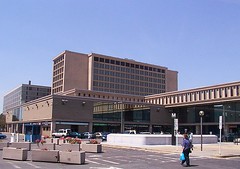Community organizing and contesting state action in DC
One of the presentations at the Historical Studies conference this past weekend was on the proposed extension of the National Mall eastward, between Constitution and Independence Avenues to the Anacostia River. I have seen renderings of this proposal, maybe at the National Building Museum or somewhere else (not in Reps Washington On View. The Nation's Capital Since 1790 or in Miller's Washington in Maps). Maps of the proposal are in the Miller book.
Lindsay Silver's (PhD student, Brandeis University) presentation considered the development of the Capitol Hill Restoration Society and an organized community opposition to this plan, proposed decades earlier, but like freeway projects, taking decades to successfully challenge and overcome.
The day before featured three presentations about Southwest DC, where such an "urban renewal" plan was not scuttled. One of the presentations was by Bell Clement (PhD student, GWU) which looked at some of the broader kinds of questions that I am more interested in.
In a side conversation after Ms. Silver's presentation I learned something that knocked my socks off! That there had been an urban renewal plan for Adams-Morgan, not much different from what happened to SW DC, but that it too was successfully scuttled by resident organizing and opposition.
Sadly, there are plenty of business interests in Adams-Morgan that still favor some of the broad ideas expressed in the URP--including demolishing the historic buildings on 18th Street NW--and the area is not a designated historic district, so it lacks the kinds of design review protections that are necessary to preserving pedestrian-centricity and the tenets of urban design.
Too few people understand the vital connection between various anti-freeway movements and neighborhood preservation movements (i.e., historic preservation) and the successful stabilization and maintenance of Washington DC as the city it is today--for example, the various freeway plans proposed the destruction of 1/3 or more of the city's historic building stock and neighborhoods.
This makes sense, because had there been historic designation, the abomination at 18th and Columbia likely would not have happened.
 The bank building at 18th Street and Columbia Road NW. Photos from maps.a9.com.
The bank building at 18th Street and Columbia Road NW. Photos from maps.a9.com. A blank wall on a major pedestrian-shopping street is a major violation of urban design.
A blank wall on a major pedestrian-shopping street is a major violation of urban design.

There are good discussions of anti-freeway organizing in Greenwich Village and New Orleans in the book The Living City. Thinking about the various DC experiences simultaneously:
(1) the SW Urban Renewal Project;
(2) Successful anti-freeway activism, specifically the "Emergency Committee on the Transportation Crisis;"
(3) the successful staving off of the East Capitol Mall project
(4) and the Urban "Renewal" Plan for Adams-Morgan
makes the question of successful and unsuccessful community organization against state action particularly interesting. Certainly, the National Historic Preservation Act and similar laws (NEPA, etc.) were a response to successful community organizing against the activities of the federal government, and the creation and provision of a process to mediate and manage such "disputes."
 Graphic from a poster from the Emergency Committee on the Transportation Crisis, the 1960s and 1970s anti-freeway activist group from Washington DC and the inner Maryland suburbs.
Graphic from a poster from the Emergency Committee on the Transportation Crisis, the 1960s and 1970s anti-freeway activist group from Washington DC and the inner Maryland suburbs.Thinking about the various ways in which citizens began challenging the federal (and other) government(s) is quite interesting. DC has a lot to contribute to this discussion, including the whole fight for home rule (see Sam Smith's memoirs, Multitudes, for a discussion of this and other community organizing issues in the 1960s and 1970s).
 Photo credit: Washington Room of MLK Library. Another building in Southwest Washington is being demolished as part of the urban renewal program. This one is at Seventh street and Virginia Avenue SW. (1957)
Photo credit: Washington Room of MLK Library. Another building in Southwest Washington is being demolished as part of the urban renewal program. This one is at Seventh street and Virginia Avenue SW. (1957)  Louise Rosskam, Farm Security Administration, circa late 1930s. Photo from Library of Congress. Southwest Washington, DC. This area was subsequently demolished in one of the first urban renewal demonstration programs in the United States.
Louise Rosskam, Farm Security Administration, circa late 1930s. Photo from Library of Congress. Southwest Washington, DC. This area was subsequently demolished in one of the first urban renewal demonstration programs in the United States. Waterfront Mall, Southwest DC. Photo: www.beyonddc.com.
Waterfront Mall, Southwest DC. Photo: www.beyonddc.com.



0 Comments:
Post a Comment
<< Home